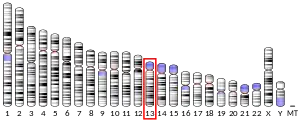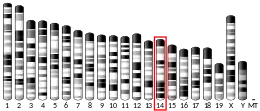Nudix hydrolase 15 is a protein that in humans is encoded by the NUDT15 gene.[5]
Function
The NUDT15 gene encodes an enzyme that belongs to the Nudix hydrolase superfamily. Members of this superfamily catalyze the hydrolysis of nucleoside diphosphates, including substrates like 8-oxo-dGTP, which are a result of oxidative damage, and can induce base mispairing during DNA replication, causing transversions. The encoded enzyme is a negative regulator of thiopurine activation and toxicity. Mutations in this gene result in poor metabolism of thiopurines, and are associated with thiopurine-induced early leukopenia. Multiple pseudogenes of this gene have been identified.
NUDT15 germline variants (e.g., a missense SNP:rs116855232, inducing R139C) have been linked to clinical usage of thiopurines (e.g., mercaptopurine) in acute lymphoblastic leukemia[6][7] as well as inflammatory bowel diseases to avoid thiopurine-induced leukopenia.[8][9] These variants also exhibit ethnicity-specific (e.g., variant allele of rs116855232 is high is East Asians and Hispanics but low in Caucasians and Africans). Rare functional variants in this gene have also been identified as being related to thiopurine-induced myelotoxicity,[10] suggesting the whole gene screening should be taken to determine the initial dosage using of thiopurine.
References
- 1 2 3 GRCh38: Ensembl release 89: ENSG00000136159 - Ensembl, May 2017
- 1 2 3 GRCm38: Ensembl release 89: ENSMUSG00000033405 - Ensembl, May 2017
- ↑ "Human PubMed Reference:". National Center for Biotechnology Information, U.S. National Library of Medicine.
- ↑ "Mouse PubMed Reference:". National Center for Biotechnology Information, U.S. National Library of Medicine.
- ↑ "Entrez Gene: Nudix hydrolase 15".
- ↑ Moriyama T, Nishii R, Perez-Andreu V, Yang W, Klussmann FA, Zhao X, et al. (April 2016). "NUDT15 polymorphisms alter thiopurine metabolism and hematopoietic toxicity". Nature Genetics. 48 (4): 367–73. doi:10.1038/ng.3508. PMC 5029084. PMID 26878724.
- ↑ Yang JJ, Landier W, Yang W, Liu C, Hageman L, Cheng C, et al. (April 2015). "Inherited NUDT15 variant is a genetic determinant of mercaptopurine intolerance in children with acute lymphoblastic leukemia". Journal of Clinical Oncology. 33 (11): 1235–42. doi:10.1200/JCO.2014.59.4671. PMC 4375304. PMID 25624441.
- ↑ Yang SK, Hong M, Baek J, Choi H, Zhao W, Jung Y, et al. (September 2014). "A common missense variant in NUDT15 confers susceptibility to thiopurine-induced leukopenia". Nature Genetics. 46 (9): 1017–20. doi:10.1038/ng.3060. PMC 4999337. PMID 25108385.
- ↑ Yin D, Xia X, Zhang J, Zhang S, Liao F, Zhang G, et al. (February 2017). "Impact of NUDT15 polymorphisms on thiopurines-induced myelotoxicity and thiopurines tolerance dose". Oncotarget. 8 (8): 13575–13585. doi:10.18632/oncotarget.14594. PMC 5355121. PMID 28088792.
- ↑ Moriyama T, Yang YL, Nishii R, Ariffin H, Liu C, Lin TN, et al. (September 2017). "Novel variants in NUDT15 and thiopurine intolerance in children with acute lymphoblastic leukemia from diverse ancestry". Blood. 130 (10): 1209–1212. doi:10.1182/blood-2017-05-782383. PMC 5606007. PMID 28659275.
Further reading
- Yu Y, Cai JP, Tu B, Wu L, Zhao Y, Liu X, et al. (July 2009). "Proliferating cell nuclear antigen is protected from degradation by forming a complex with MutT Homolog2". The Journal of Biological Chemistry. 284 (29): 19310–20. doi:10.1074/jbc.M109.015289. PMC 2740556. PMID 19419956.
- Hori M, Satou K, Harashima H, Kamiya H (May 2010). "Suppression of mutagenesis by 8-hydroxy-2'-deoxyguanosine 5'-triphosphate (7,8-dihydro-8-oxo-2'-deoxyguanosine 5'-triphosphate) by human MTH1, MTH2, and NUDT5". Free Radical Biology & Medicine. 48 (9): 1197–201. doi:10.1016/j.freeradbiomed.2010.02.002. hdl:2115/43020. PMID 20144704.
- Yang SK, Hong M, Baek J, Choi H, Zhao W, Jung Y, et al. (September 2014). "A common missense variant in NUDT15 confers susceptibility to thiopurine-induced leukopenia". Nature Genetics. 46 (9): 1017–20. doi:10.1038/ng.3060. PMC 4999337. PMID 25108385.
- Yang JJ, Landier W, Yang W, Liu C, Hageman L, Cheng C, et al. (April 2015). "Inherited NUDT15 variant is a genetic determinant of mercaptopurine intolerance in children with acute lymphoblastic leukemia". Journal of Clinical Oncology. 33 (11): 1235–42. doi:10.1200/JCO.2014.59.4671. PMC 4375304. PMID 25624441.
- Tanaka Y, Kato M, Hasegawa D, Urayama KY, Nakadate H, Kondoh K, et al. (October 2015). "Susceptibility to 6-MP toxicity conferred by a NUDT15 variant in Japanese children with acute lymphoblastic leukaemia". British Journal of Haematology. 171 (1): 109–15. doi:10.1111/bjh.13518. PMID 26033531.
- Kakuta Y, Naito T, Onodera M, Kuroha M, Kimura T, Shiga H, et al. (June 2016). "NUDT15 R139C causes thiopurine-induced early severe hair loss and leukopenia in Japanese patients with IBD". The Pharmacogenomics Journal. 16 (3): 280–5. doi:10.1038/tpj.2015.43. PMID 26076924.
- Carter M, Jemth AS, Hagenkort A, Page BD, Gustafsson R, Griese JJ, et al. (August 2015). "Crystal structure, biochemical and cellular activities demonstrate separate functions of MTH1 and MTH2". Nature Communications. 6: 7871. Bibcode:2015NatCo...6.7871C. doi:10.1038/ncomms8871. PMC 4532830. PMID 26238318.
- Chiengthong K, Ittiwut C, Muensri S, Sophonphan J, Sosothikul D, Seksan P, et al. (January 2016). "NUDT15 c.415C>T increases risk of 6-mercaptopurine induced myelosuppression during maintenance therapy in children with acute lymphoblastic leukemia". Haematologica. 101 (1): e24-6. doi:10.3324/haematol.2015.134775. PMC 4697903. PMID 26405151.
- Liang DC, Yang CP, Liu HC, Jaing TH, Chen SH, Hung IJ, et al. (November 2016). "NUDT15 gene polymorphism related to mercaptopurine intolerance in Taiwan Chinese children with acute lymphoblastic leukemia". The Pharmacogenomics Journal. 16 (6): 536–539. doi:10.1038/tpj.2015.75. PMID 26503813. S2CID 13955512.
External links
- Overview of all the structural information available in the PDB for UniProt: Q9NV35 (Nucleotide triphosphate diphosphatase NUDT15) at the PDBe-KB.
This article incorporates text from the United States National Library of Medicine, which is in the public domain.



